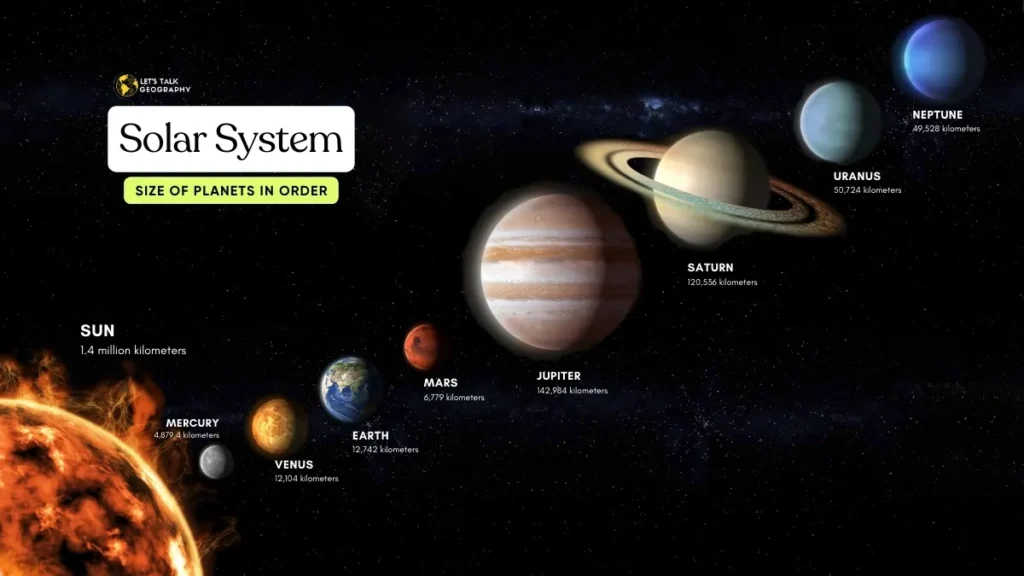Introduction
Imagine holding a tiny Earth in your hand and wondering how many more could fit inside the colossal sphere of the Sun. The answer reveals astonishing insights into the scale of our solar system. The Sun, a massive star at the center of our solar system, dwarfs all planets, including Earth. Its immense size and energy output make it vital to our cosmic neighborhood.
Understanding ‘How many Earths can fit in the Sun?’ satisfies our curiosity and enhances our comprehension of astronomical scales and the vastness of the universe. This knowledge helps us appreciate the Sun’s important role in sustaining life on Earth and the dynamics of our solar system. Grasping the scale of the Sun compared to Earth is essential for appreciating the enormity of our solar system and the relative sizes of celestial bodies, fostering a deeper interest in astronomy.
The article will cover the sizes of the Earth and the Sun, the mathematical calculations to determine how many Earths fit in the Sun, and the significance of these findings in an astronomical context.
Introduction to the Scale of the Solar System
The solar system is a vast and thrilling expanse, with the sun at its center influencing size and other features. Interpreting how many earths can fit in the sun gives a fascinating outlook into the massive scale of our celestial neighborhood, highlighting the tremendous size difference between the planets and the Sun.
Understanding the immense size of celestial bodies in our solar system begins with a simple yet mind-boggling question: How many Earths can fit in the Sun? This question highlights the sheer enormity of our star and provides a fascinating entry point into exploring the solar system’s scale. Our Sun, a blazing sphere of hydrogen and helium, dwarfs all the planets combined, including Earth. By examining this comparison, we can better grasp the extraordinary dimensions of space and the place of our planet within it. This article will take you on a journey through the vast expanses of our solar system, revealing the astonishing sizes and distances that define our cosmic home.
Understanding the Sizes of Earth and the Sun:

Size of the Earth:
With a diameter of about 7926 miles, the Earth is the most massive terrestrial planet and the fifth largest in our solar system. At a mean distance of 93 million miles (150 million kilometers), Earth is one such astronomical unit distant from the Sun due to one astronomical unit: the space from the Sun to Earth. Light from the Sun requires about eight minutes to reach our planet.
Size of the Sun:
When contemplating the “Size of the Sun,” it’s hard to grasp its true magnitude. This massive star, a nearly perfect sphere of hot plasma, is about 1.39 million kilometers (864,000 miles) in diameter, making it 109 times wider than Earth. Its immense volume could encompass approximately 1.3 million Earths, illustrating the sheer scale of this stellar behemoth. The Sun’s size is not merely a matter of curiosity but a fundamental aspect of its influence on the solar system. Its gravitational pull governs the orbits of planets, comets, and asteroids, while its radiant energy sustains life on Earth. Understanding the Sun’s size provides a window into the dynamics of our solar system and the forces that shape our cosmic neighborhood.
The Sun is nearly 100 times wider than Earth and about ten times bigger than Jupiter. The sun is a medium star with a radius of 435000 miles. The Sun is much, much bigger than the Earth and would take 330000 Earths to match the mass of the Sun.
Calculation of How Many Earths Can Fit in the Sun:
Mathematical Approach:
Volume = 4/3πr3
where r= radius of the sphere.
The radius of the Sun =696,340 km
Using the formula, the volume of the Sun V sun= 4/3 π(696,340)3
The volume of the earth
The radius of the Earth is 6,3716,3716,371 km.
Using the formula, the volume of the Earth (VEarth) is: V earth= 4/3 π(6,371)3
● Calculate the volume of the Sun:
VSun≈4/3π(696,340)3≈1.41×1018km3
● Calculate the volume of the Earth:
VEarth≈4/3π(6,371)3≈1.08×1012km3
● Determine how many Earths fit into the Sun:
Number of Earths=VSun/VEarth≈1.08×10121.41×1018≈1.3×106Thus, approximately 1.3 million Earths can fit inside the Sun.
Conclusion:
In exploring the question “How many Earths can fit in the Sun,” we delved into the staggering dimensions of our solar system’s star. The Sun’s diameter of approximately 1.39 million kilometers and its vast volume, capable of containing about 1.3 million Earths, underscore its colossal size. This comparison highlights the Sun’s dominant presence and critical role in maintaining the solar system’s gravitational balance and energetic dynamics. Understanding these facts satisfies our curiosity and deepens our appreciation for the Sun’s immense influence on our cosmic environment.
In summary, understanding the immense scale of the Sun compared to Earth provides a fascinating glimpse into the vastness of our solar system. By exploring how many Earths can fit into the Sun, we acquired a deeper appreciation for the enormity of our star and its dominant role in the solar system. This exploration satisfies our curiosity and highlights the significance of studying astronomical scales to comprehend the universe’s structure better. As we delve further into this topic, we will uncover the calculations and comparisons that vividly illustrate this astounding scale difference, providing a clear and engaging understanding of the Sun’s grandeur. This article aims to make these complex astronomical concepts accessible and captivating for all readers.
References:
- (N.d.). Nasa.gov. Retrieved May 28, 2024, from https://www.nasa.gov/wp-content/uploads/2015/01/yoss_act1.pdf
- Earth. (2023, May 30). Nasa.gov. https://science.nasa.gov/earth/facts/
- Sun: Facts – NASA science. (2017, November 14). Nasa.gov. https://science.nasa.gov/sun/facts/
- Haigh, C. (2022, August 19). How many earths can fit inside the sun? IFLScience. https://www.iflscience.com/how-many-earths-can-fit-inside-the-sun-64940

